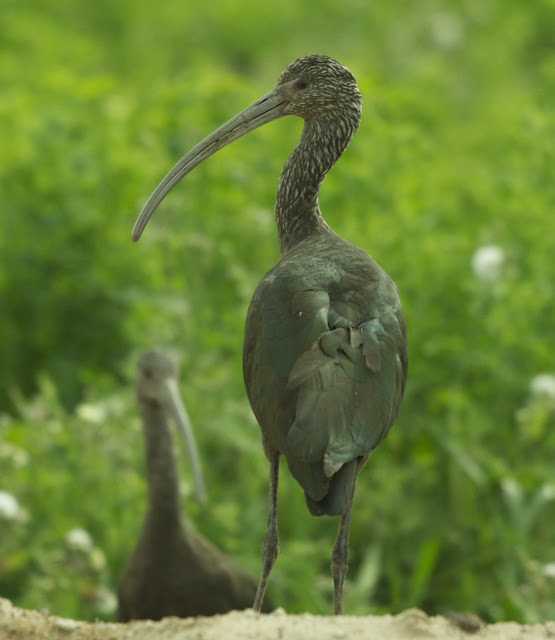It's quite the farfetched comparison, and probably not one that could be sustained for very long, but even so, if you visit the Arlington Wildlife Refuge and the surrounding farmland in the right time of year, it feels pretty swampy, pretty evergladesy. It will always be lacking the wader diversity and large carnivorous lizards of the Florida swamps, but a visit here can still supply some of that satisfaction that comes with birding a somewhat tropical, verdant area.
The wetlands themselves are not particularly expansive, nowhere near the size or diversity of Tres Rios or the Gilbert Water Ranch, but they're still good spring and summer spots for Yellow-headed Blackbirds, Black-crowned Night Herons, Sora, Virginia, and maybe even Clapper Rail.
The Rails don't show very often, but the YHBB's are very conspicuous right now, perched atop their stalks and letting fly with their metallic, watery call. Their numbers aren't huge, but the Arlington marsh is one area where they seem to actually outnumber the Red-winged Blackbirds, who are, for whatever, reason, less conspicuous. The only other place where YHBBs outnumber the RWBBs is around a cattle feed troughs, which are generally less pleasant to investigate.
For me, the main attraction of the Arlinton area is not the Wildlife Refuge, though it's always worth a quick walkthrough, but the grassy farmland that lies just to the north. In March and April the combination of irrigation and rain showers, along with the warmer temperatures, promotes a sudden and expansive growth in all the fields. Like the birds, I then feel an intense desire to take of my shoes and go walk around in it, the ground being soft and moist (a rare thing in central AZ) and the grass being soft and lush (another rare thing in Arizona).
While walking around the perimeters of these fields, the bird diversity drops down, but the numbers of the birds goes up, if you can pick out the pods. What's all this then?
Ah, of course, it is a crowd of Ibis, White-faced to be precise, grazing in the greenery.
One of several bird species to be found in the Arlington area with very prominent proboscises, The White-faced Ibis is not living up to its namesake right now, but will develop the white face outline later on. For the moment, it's almost a Glossy...(Arizona birders wish).
Large flocks, numbering in the sixties and seventies, of Ibis and Egrets lope through the marshy grass, and smaller bands of marauding members of the Yellowlegs clan work the spaces in-between.

Violence is rare on the Arlington fields, even while Harriers often buzz overhead, but there is a certain understood jockeying for position. The birds that combine to be the largest/most numerous tend to monopolize the best feeding areas. Smaller birds in smaller groups, like these Yellowlegs, wait until the Egrets or Ibis spook or drift, and then move into the prime territory.

I was observing these charming dynamics when another one of the heavy-hitter gangs rolled into town. Largest sandpiper in North America, large numbers, impressive hardware...the Long-billed Curlews are not a group with whom one should trifle.
The Curlews are also one of the less common wading birds to find in the fields, though Arlington is still one of the best places to scan for them. I was lucky on this day when the herd (that is the proper term) of Curlew landed just fifty yards or so away, full of probing confidence.
March was a good time to observe these birds, as plenty of younger models made for interesting size comparisons, both in overall body mass and in bill length. In the photo below, the bird in the top left corner can't really be mistaken for anything else, but the foreground birds, at a distance or with some forgetting of facial patterns, could be taken for Whimbrels.
Lookit the monstrous beaks on these rockstars. The earthworms and insects, already given serious anxiety from the fields' flooding, do not stand a chance. Like many shorebirds, Curlews have a certain economy of style with their coloration, but the intricate plumage within the brown and cinnamon spectrum is fascinating, indeed, gorgeous.

Maybe my billing of the Arlington riparian area as the Arizona everglades is hyperbole. After all, there are no Spoonbills or Tri-colored Herons, but you could still maybe operate the fields with a fan-boat, and for finding big flocks of waders there are few places better in central Arizona.











